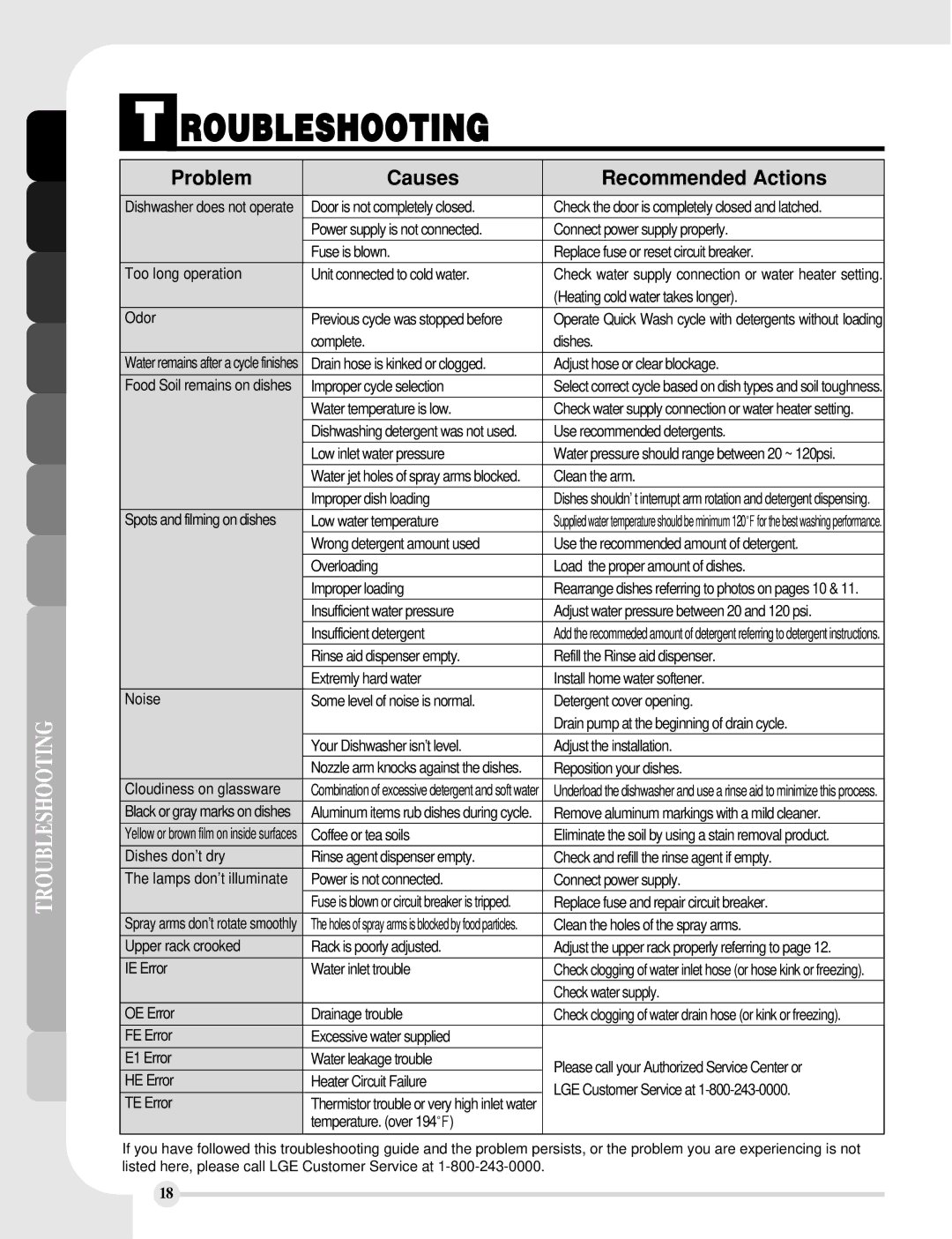
TROUBLESHOOTING
T ROUBLESHOOTING
Problem | Causes | Recommended Actions | |
|
|
| |
Dishwasher does not operate | Door is not completely closed. | Check the door is completely closed and latched. | |
|
|
| |
| Power supply is not connected. | Connect power supply properly. | |
| Fuse is blown. | Replace fuse or reset circuit breaker. | |
Too long operation | Unit connected to cold water. | Check water supply connection or water heater setting. | |
|
| (Heating cold water takes longer). | |
Odor | Previous cycle was stopped before | Operate Quick Wash cycle with detergents without loading | |
| complete. | dishes. | |
Water remains after a cycle finishes | Drain hose is kinked or clogged. | Adjust hose or clear blockage. | |
Food Soil remains on dishes | Improper cycle selection | Select correct cycle based on dish types and soil toughness. | |
| Water temperature is low. | Check water supply connection or water heater setting. | |
|
|
| |
| Dishwashing detergent was not used. | Use recommended detergents. | |
|
|
| |
| Low inlet water pressure | Water pressure should range between 20 ~ 120psi. | |
|
|
| |
| Water jet holes of spray arms blocked. | Clean the arm. | |
| Improper dish loading | Dishes shouldn’ t interrupt arm rotation and detergent dispensing. | |
Spots and filming on dishes | Low water temperature | Suppliedwatertemperatureshouldbeminimum120℉ forthebestwashingperformance. | |
| Wrong detergent amount used | Use the recommended amount of detergent. | |
|
|
| |
| Overloading | Load the proper amount of dishes. | |
|
|
| |
| Improper loading | Rearrange dishes referring to photos on pages 10 & 11. | |
| Insufficient water pressure | Adjust water pressure between 20 and 120 psi. | |
| Insufficient detergent | Add the recommeded amount of detergent referring to detergent instructions. | |
| Rinse aid dispenser empty. | Refill the Rinse aid dispenser. | |
| Extremly hard water | Install home water softener. | |
Noise | Some level of noise is normal. | Detergent cover opening. | |
|
| Drain pump at the beginning of drain cycle. | |
| Your Dishwasher isn’t level. | Adjust the installation. | |
| Nozzle arm knocks against the dishes. | Reposition your dishes. | |
Cloudiness on glassware | Combination of excessive detergent and soft water | Underload the dishwasher and use a rinse aid to minimize this process. | |
Black or gray marks on dishes | Aluminum items rub dishes during cycle. | Remove aluminum markings with a mild cleaner. | |
Yellow or brown film on inside surfaces | Coffee or tea soils | Eliminate the soil by using a stain removal product. | |
Dishes don’t dry | Rinse agent dispenser empty. | Check and refill the rinse agent if empty. | |
The lamps don’t illuminate | Power is not connected. | Connect power supply. | |
|
|
| |
| Fuse is blown or circuit breaker is tripped. | Replace fuse and repair circuit breaker. | |
Spray arms don’t rotate smoothly | The holes of spray arms is blocked by food particles. | Clean the holes of the spray arms. | |
Upper rack crooked | Rack is poorly adjusted. | Adjust the upper rack properly referring to page 12. | |
IE Error | Water inlet trouble | Check clogging of water inlet hose (or hose kink or freezing). | |
|
|
| |
|
| Check water supply. | |
OE Error | Drainage trouble | Check clogging of water drain hose (or kink or freezing). | |
FE Error | Excessive water supplied |
| |
E1 Error | Water leakage trouble | Please call your Authorized Service Center or | |
HE Error | Heater Circuit Failure | ||
LGE Customer Service at | |||
TE Error | Thermistor trouble or very high inlet water | ||
| |||
| temperature. (over 194℉) |
| |
|
|
|
If you have followed this troubleshooting guide and the problem persists, or the problem you are experiencing is not listed here, please call LGE Customer Service at
18
